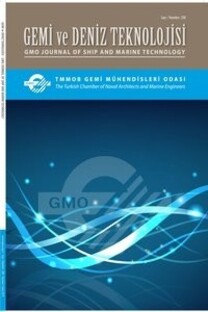Denizaltılarında Havadan Bağımsız Tahrik Sistemi Olarak Kullanılan MESMA Sisteminin Termodinamik Performans Analizi
Termodinamik analiz, Havadan bağımsız tahrik, MESMA, Denizaltı, Gemi makineleri, Yanma Analizi.
Thermodynamic Performance Analysis of the MESMA System Used as an Air-Independent Propulsion System in Submarines
Thermodynamic analysis, Air independent propulsion, MESMA, Submarine, Ship Machines, Combustion Analysis,
___
- Bedir F., Alniak M.O., 2004. Yakıt Pil Sistemlerinin ÇalıĢma Prensibi Ve Denizaltı Sistemlerdeki Tasarımı. Makine Teknolojileri Elektronik Dergisi 31–37.
- Burcher, R., Rydill, L., 1994. Concepts in submarine design, Cambridge ocean technology series. Cambridge University Press, Cambridge [England] ; New York.
- Edward C. Whitman, n.d. Air-Indipendent Propulsion. AIP Technology Creates a New Undersea Threat 1–6.
- Ferguson CR., 1986. Internal combustion engines – applied thermosciences., New York: John Wiley&Sons Inc.; ed. Fiori, C., Dell’Era, A., Zuccari, F., Santiangeli, A., D’Orazio, A., Orecchini, F., 2015. Hydrides for submarine applications: Overview and identification of optimal alloys for air independent propulsion maximization. International Journal of Hydrogen Energy 40, 11879–11889.
- G. Gonca, I. Ozsari, 2016. Exergetic Performance Analysis of a Gas Turbine with two Intercoolers and two Reheaters Fuelled with Different Fuel Kinds. CONFERENCE ON ADVANCES IN MECHANICAL ENGINEERING ISTANBUL 2016.
- Gonca, G., Genc, I., 2019. Thermoecology-based performance simulation of a Gas-Mercury-Steam power generation system (GMSPGS). Energy Conversion and Management 189, 91–104.
- Han, Jaeyoung, Han, Jaesu, Ji, H., Yu, S., 2020. “Model-based” design of thermal management system of a fuel cell “air-independent” propulsion system for underwater shipboard. International Journal of Hydrogen Energy 45, 32449–32463.
- https://klswatch.wordpress.com/2011/06/22/second-dcnss-mesma%C2%AE-aip-ready-for-shipment-to-pakistan/, n.d.
- https://uboat.net/types/walter_hist.htm, n.d.
- Kerros, P., Inizan, C., Grousset, D., 1994. MESMA: AIP system for submarines, in: Proceedings of OCEANS’94. Presented at the OCEANS’94, IEEE, Brest, France, p. III/457-III/466. https://doi.org/10.1109/OCEANS.1994.364242
- Lee J.-C., Shay T., 2018. ANALYSIS OF FUEL CELL APPLIED FOR SUBMARINE AIR INDEPENDENT PROPULSION (AIP) SYSTEM. Journal of Marine Science and Technology 26, 657–666.
- Lefebvre, A.H., Ballal, D.R., 2010. Gas turbine combustion alternative fuels and emissions. Taylor & Francis, Boca Raton [u.a.
- Menon, R.R., Vijayakumar, R., Pandey, J.K., 2020. Selection of Optimal Air Independent Propulsion System using Forced Decision Matrix. Def. Sc. Jl. 70, 103–109.
- Mohammed Shibil Kurikkal, 2016. Air Independent Propulsion; Silent Submarines with Stirling Engines. International Journal of Engineering Research & Technology (IJERT) 5, 240.
- Ozsari, I., Ust, Y., 2019. Effect of varying fuel types on oxy‐combustion performance. Int J Energy Res er.4868.
- Ozsari, I., Ust, Y., Kayadelen, H.K., 2021. Comparative Energy and Emission Analysis of Oxy-Combustion and Conventional Air Combustion. Arab J Sci Eng 46, 2477–2492.
- Ozturan, H., 2017. IdeaLab’dan Sessiz Denizaltılar için Devrim Yaratacak Teknoloji: sCO2 Brayton Güç Çevrimi. MSI IDEF 172.
- Park, E.-Y., Choi, J., 2020. The Performance of Low-Pressure Seawater as a CO2 Solvent in Underwater Air-Independent Propulsion Systems. JMSE 8, 22.
- Persson, O., Östberg, C., Pagels, J., Sebastian, A., 2006. Air contaminants in a submarine equipped with air independent propulsion. J. Environ. Monit. 8, 1111–1121.
- Peter L. Mart, Jenny Margeridis, 1995. Fuel Cell Air Independent Propulsion of Submarines. DSTO Aeronautical and Maritime Research Laboratory, Avusturalya DSTO-GD-0042.
- Pommer, H., Hauschildt, P., Teppner, R., Hartung, W., 2006. Air-independent propulsion system for submarines. ThyssenKrupp techforum 64–69.
- Psallidas, K., Whitcomb, C.A., Hootman, J.C., 2010. Design of Conventional Submarines with Advanced Air Independent Propulsion Systems and Determination of Corresponding Theater-Level Impacts: Design of Conventional Submarines. Naval Engineers Journal 122, 111–123.
- Psoma, A., Sattler, G., 2002. Fuel cell systems for submarines: from the first idea to serial production. Journal of Power Sources 106, 381–383.
- Rashad, M.I., Nada, S.A., 2021. Experimental and theoretical investigation on a proposed free piston Stirling engine with expansion bellow. Applied Thermal Engineering 182, 116071.
- Raska, M., 2016. Diesel-Electric Submarine Modernization in Asia: The Role of Air-Independent Propulsion Systems, in: Bitzinger, R.A. (Ed.), Emerging Critical Technologies and Security in the Asia-Pacific. Palgrave Macmillan UK, London, pp. 91–106.
- Turns, S.R., 2011. An introduction to combustion: concepts and applications, 3. ed. ed. McGraw-Hill, Boston.
- Ust, Y., Sahin, B., Sogut, O.S., 2005. Performance analysis and optimization of an irreversible dual-cycle based on an ecological coefficient of performance criterion. Applied Energy 82, 23–39.
- ISSN: 1300-1973
- Yayın Aralığı: Yılda 2 Sayı
- Başlangıç: 1955
- Yayıncı: TMMOB Gemi Mühendisleri Odası
Dönebilir İticinin Sert Hava Koşullarında Bir Balıkçı Gemisinin Manevra Kabiliyetine Etkisi
Kadir SARIÖZ, Ömer GÖREN, Ömer Kemal KINACI, Aydin SULUS
Otonom Su Üstü Araçları için COLREG Kurallarını İçeren Çarpışma Önleyici Sistem
Bodrum Yat İnşa Sektörünün GZFT/PESTLE Analizi
Bülent İbrahim TURAN, Mehmet AKMAN, Fuat TURAN
Denizaltılarda Stirling Motor Temelli Havadan Bağımsız Tahrik Sistemlerinin (AIP) Değerlendirilmesi
Kadir Beytulllah GÜNDÜZ, Yasemin ARIKAN ÖZDEN
Eklemeli İmalat Teknikleri ve Gemi İnşaatı Endüstrisindeki Potansiyeli
Ali ALICIOĞLU, M. Erden YILDIZDAG
Açık Kaynaklı Panel Yöntemi Kodlarının Ticari Kod ile Karşılaştırılması ve Değerlendirilmesi
Muhammed UÇAR, Emre UZUNOĞLU, Elif OĞUZ
Dikili Açıklarında Bir Açık Deniz Rüzgâr Çiftliğinin Kavramsal Tasarımı
